Jump to: Historical Background | Factors Affecting Value | Rarity Of The Lincoln Memorial Penny | Condition And Wear | Impact Of The Design On Value | How Color Affects Values | Significance Of Mint Marks | Varieties and Errors
Key Takeaways
- The new design of the 1959 Lincoln Memorial pennies, with significant design errors or unique varieties, can be particularly valuable.
- The classification of a Lincoln Memorial Penny's color (Red, Red-Brown, Brown) reflects its preservation. Coins that retain a red hue are generally more valuable due to their better condition.
- The auction record for a Philadelphia Red Lincoln Memorial coin is $5,887 for an MS67+. As from the Denver mint, the auction record for a Red MS68 is $6,999.
- The price record for a double-die error coin is $2,000 for a Red MS66 (FS-104) variety.
- The auction record for a Repunched Mint Mark error coin in MS65 condition is $176.
In this article, we will explore the key factors that influence the value of a 1959 Lincoln Penny. Examining these coins is essential due to their prevalence and their role as a typical starting point for new coin collectors.
We will explain the significance of understanding the value of 1959 pennies and highlight the crucial factors that affect their worth.
Historical Background on the Lincoln Memorial Pennies
1959 marked the 50th anniversary of the Lincoln Cent, making it an opportune moment for a design update. The production of the Lincoln Memorial Penny started in January 1959, but the coin was officially released on February 12, 1959, the 150th anniversary of Lincoln's birth.
While the obverse depicting President Abraham Lincoln remained unchanged, the reverse design was altered from the traditional "Wheat Ears" to a frontal view of the Lincoln Memorial.
Consequently, Lincoln is featured twice on the New cent: once on the obverse and again as a small figure seated at the center of his memorial on the reverse.
Collectors and historians alike admire this penny for its artistic value. It connects the present and the past while paying tribute to Lincoln's lasting legacy.
Read more about Wheat Pennies and their values.
Factors Affecting 1959 Lincoln Memorial Penny Value
The Rarity Of The Lincoln Memorial Penny
The rarity of a coin also significantly impacts its value. Limited supply means there are fewer coins available, which drives up demand among collectors and investors, resulting in higher prices.
Rare coins often carry historical significance, such as being from a specific era or having unique mint errors, which further enhances their desirability to every collector.
In general, finding 1959 Lincoln cents in mint condition is rare, while circulated grades are relatively common. This rarity makes uncirculated coins significantly more valuable than their circulated counterparts.
Influence Of A Coin's Condition And Wear
Understanding the grading and condition of the 1959 Lincoln Memorial Penny is essential for anyone interested in collecting these coins or looking to sell them.
Coin grading evaluates a coin's condition using the Sheldon Scale, which ranges from 1 (poor condition) to 70 (perfect condition). The Professional Coin Grading Service (PCGS) is a leading authority in this process.
Accurate grading is vital for determining a coin's market value. Higher grades, typically mint condition (MS60-MS70), fetch higher values due to their rarity and appeal.
Standardized grading ensures fair transactions and transparency, making graded coins, even those in circulated condition, easier to trade since they usually come certified and are often encapsulated in protective slabs.
Impact Of The Coin's Design On Its Value
A coin's design can significantly affect its value, with aesthetically appealing designs being more desirable and those with cultural or symbolic value often commanding higher prices. Coins from popular series or with iconic designs attract greater demand and higher market value.
For example, the Lincoln Series broke new ground in American coinage by featuring a real person, which was unprecedented for circulation coins at the time. Furthermore, the 1959 Lincoln Memorial Penny was the first year in which the Mint produced Lincoln cents with the Memorial reverse design.
OBVERSE
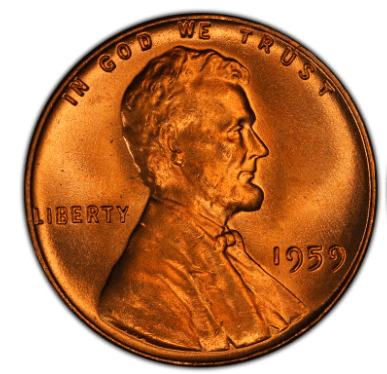
The obverse of the Memorial Lincoln Cent features a right-facing portrait of Abraham Lincoln, the 16th President of the United States.
This iconic image, designed by Victor David Brenner, has been on the penny since 1909, commemorating the centennial of Lincoln's birth. Surrounding Lincoln's portrait are the inscriptions "IN GOD WE TRUST" at the top, "LIBERTY" to the left, and the year of minting to the right.
REVERSE
The reverse design of the Memorial Lincoln Cent, introduced in 1959 to commemorate its 50th anniversary, depicts the Lincoln Memorial in Washington, D.C. Frank Gasparro created this design.
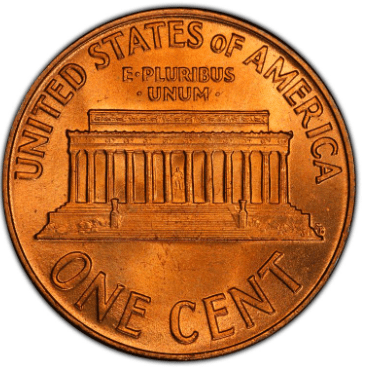
The central image shows the frontal view of the Lincoln Memorial, with a tiny representation of the seated statue of Lincoln visible in the center. Above the memorial, the inscription "UNITED STATES OF AMERICA" is curved along the top edge, with "E PLURIBUS UNUM" directly below it. At the bottom, the face value of "ONE CENT" is prominently displayed.
As one of the first series collectors commonly begin with, the Lincoln penny's unique design continues to hold a special place in numismatics, further enhancing its appeal and worth.
How Color Affects Copper Coins's Values
Copper coins are classified by their hues into Red, Red-Brown, and Brown categories based on how their composition reacts to environmental exposure. Copper begins to oxidize upon contact with air, leading to these designations.
A 1959 Penny, primarily composed of copper with 5% zinc, is classified as "Red" by PCGS if it retains 95% or more of its original mint red hue. This red coloration indicates the coin's freshness and minimal exposure to circulation or environmental elements.
A coin with a reddish tone generally suggests less wear and better condition, which can significantly increase its market value, while a coin of a brown color usually sells for less.
Significance Of Mint Marks And Their Effect On 1959 Lincoln Penny Value
The 1959 pennies were minted at both the Denver and Philadelphia Mints. The mint marks on these coins are crucial for determining their value, as they indicate the minting location, which influences factors such as scarcity and condition rarity.
For example, the Denver facility produced more coins than the Philadelphia branch, resulting in a higher survival rate of coins in better condition. While there are no registered Red MS68 condition coins from Philadelphia, PCGS values a Red MS68 coin from Denver at $9,000.
Varieties and Errors
Please see below for a list of the most significant varieties and errors of the 1959 penny issue, categorized by their value based on the criteria discussed earlier.
Keep in mind that while a coin may be valued at a certain price, auction results can vary due to the dynamics of the bidding process.
1959 1C Philadelphia, Red (Regular Strike)

With a mintage of 609,715,000, the Philadelphia branch is estimated to have around 75,000 coins surviving in MS65 condition or better.
According to the PCGS Price Guide, Superb Gem Uncirculated coins (MS67+) can sell for $3,000.
The Auction Record for a Philadelphia Red Lincoln Memorial coin was $5,887 for an MS67+ (Mint State, with grade 67+) sold by Heritage Auctions in 2016.
1959 1C Philadelphia, Double Die Obverse FS-101, Red (Regular Strike)
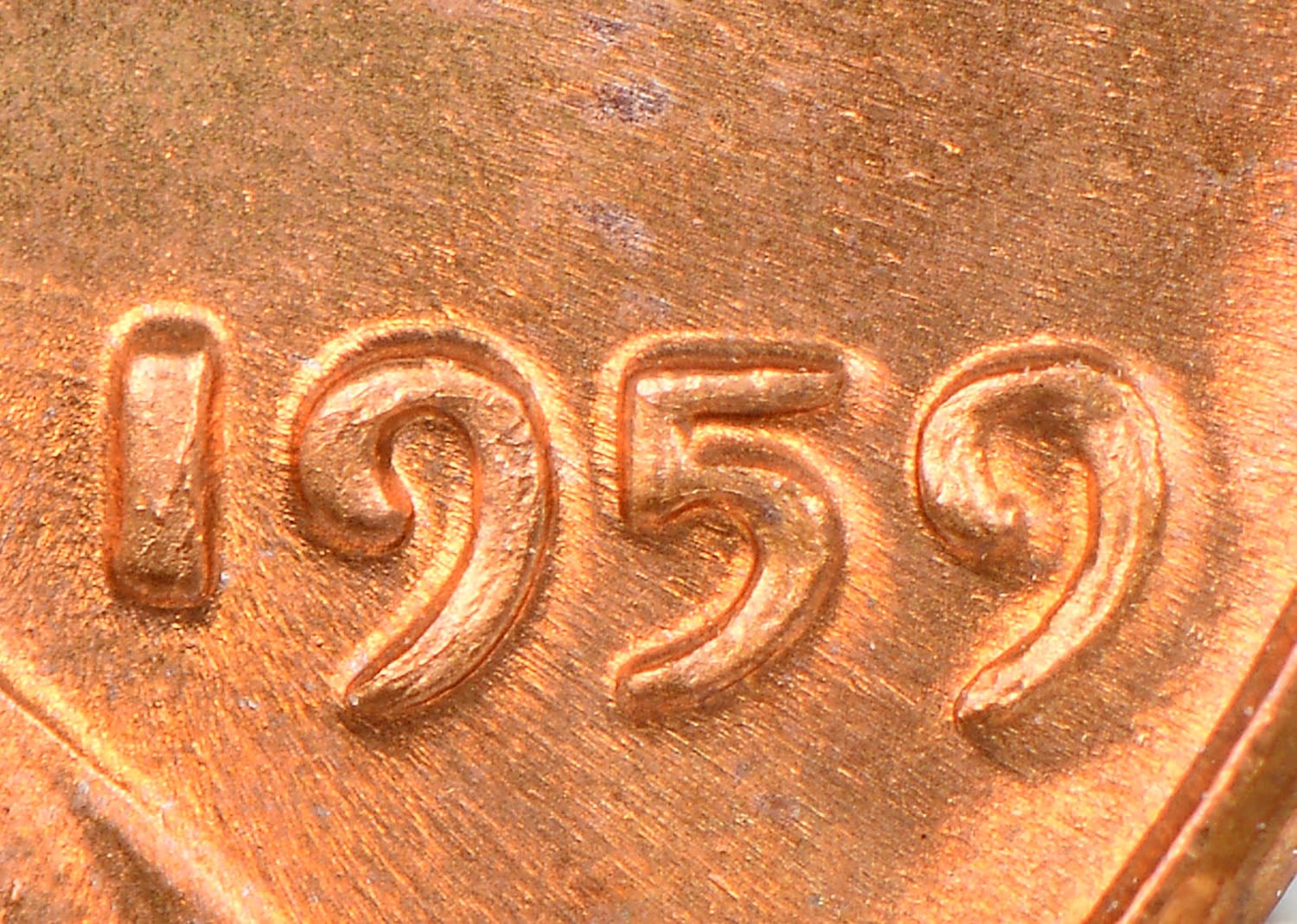
The gem's Uncirculated (MS66) condition is valued at around $850, and there is no registered finer condition.
The doubling can be observed as extra thickness in all the numerals of the date.
The Auction Record for an exemplar was in 2016, when a Red coin graded MS66 was sold for $823 at Heritage Auctions.
1959 1C Philadelphia Double Die Obverse FS-104, Red (Regular Strike)
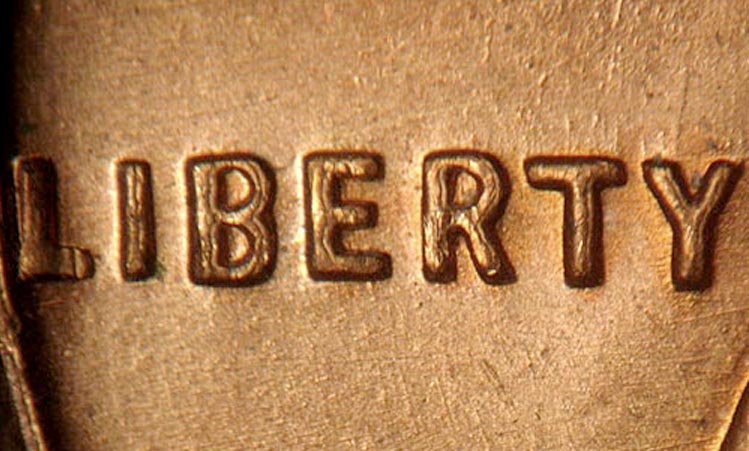
Another variation of the double die error shows a minor doubling on "LIBERTY" and "IN GOD WE TRUST."
In Gem Uncirculated (MS66), a Red coin can go for selling at $2,000.
However, the record price for a Red MS66 coin was $285, achieved on eBay in 2019.
1959 1C Denver, Red (Regular Strike)
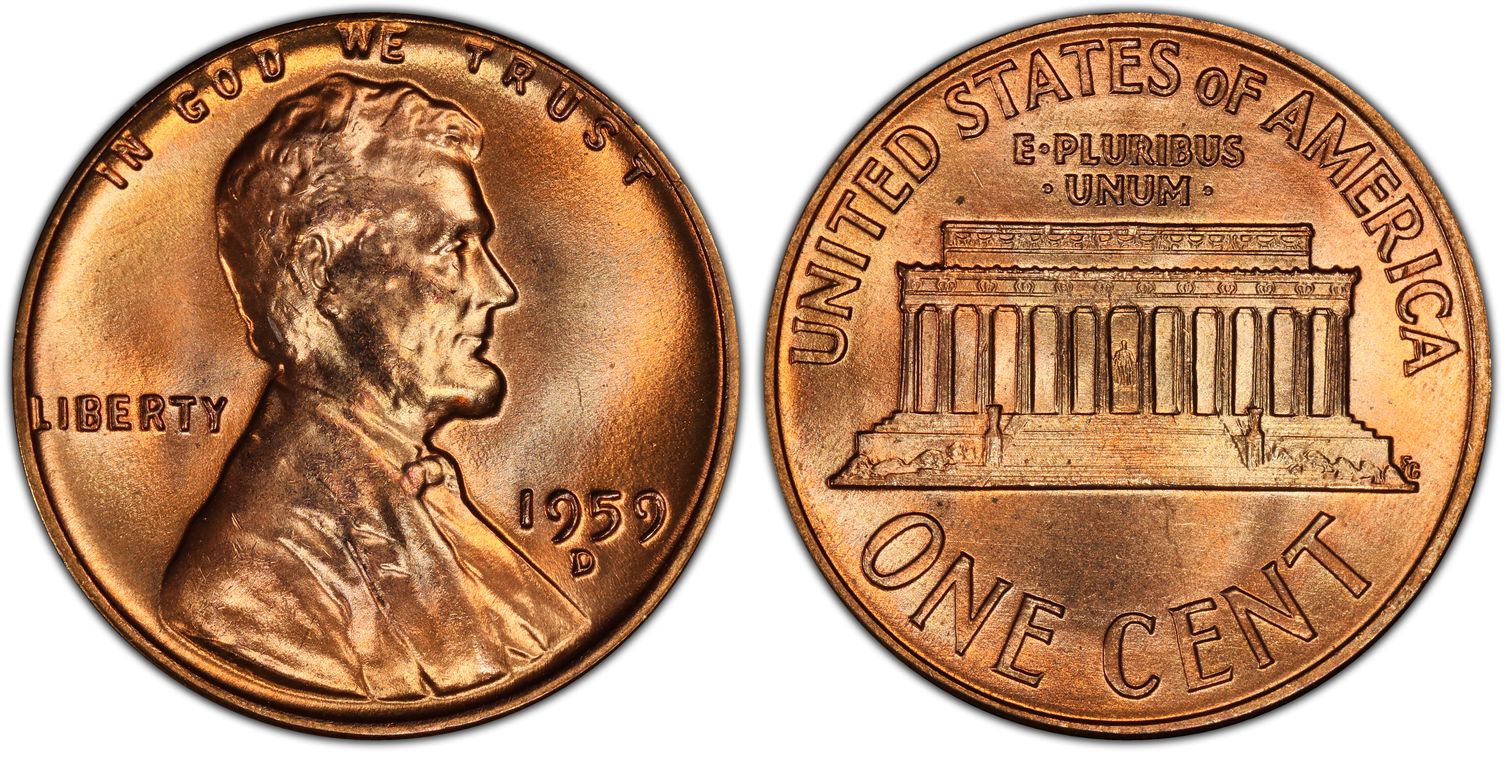
With a mintage of 1,279,760,000, the Denver facility produced the 1959-D Lincoln cent, which is among the best-struck coins in the Memorial Lincoln cent series from 1959 to 1973.
An estimated 100,000 of these coins have survived in MS65 condition or better. In Superb Gem Uncirculated condition, this coin can sell for $9,000.
Nevertheless, the auction record for an MS68RD 1959-D Lincoln cent is $6,999, achieved in 2021 via eBay.
1959 1C Denver, Repunched Mint Mark, Red (Regular Strike)
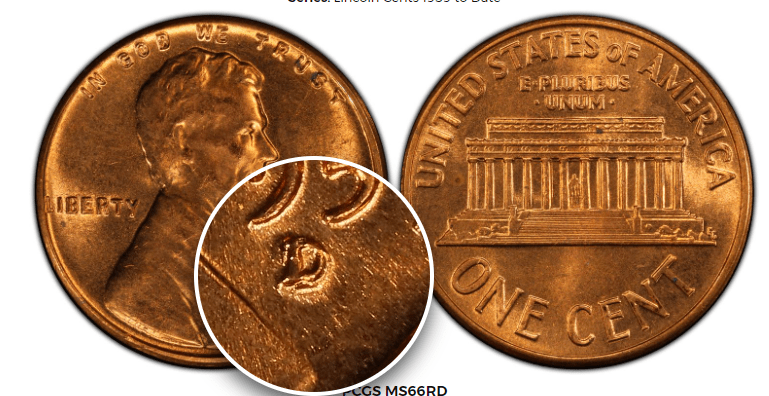
The repunched mintmark is another type of mint error, characterized by the presence of at least two mintmark impressions that are typically offset and overlapping.
In rare instances, repunched mintmarks can create two completely separated mintmark impressions.
The record price for this one was a Red MS65 coin, sold for $176 at Great Collections in 2012.
1959 1C Philadelphia, Deep Cameo, Proof Strike
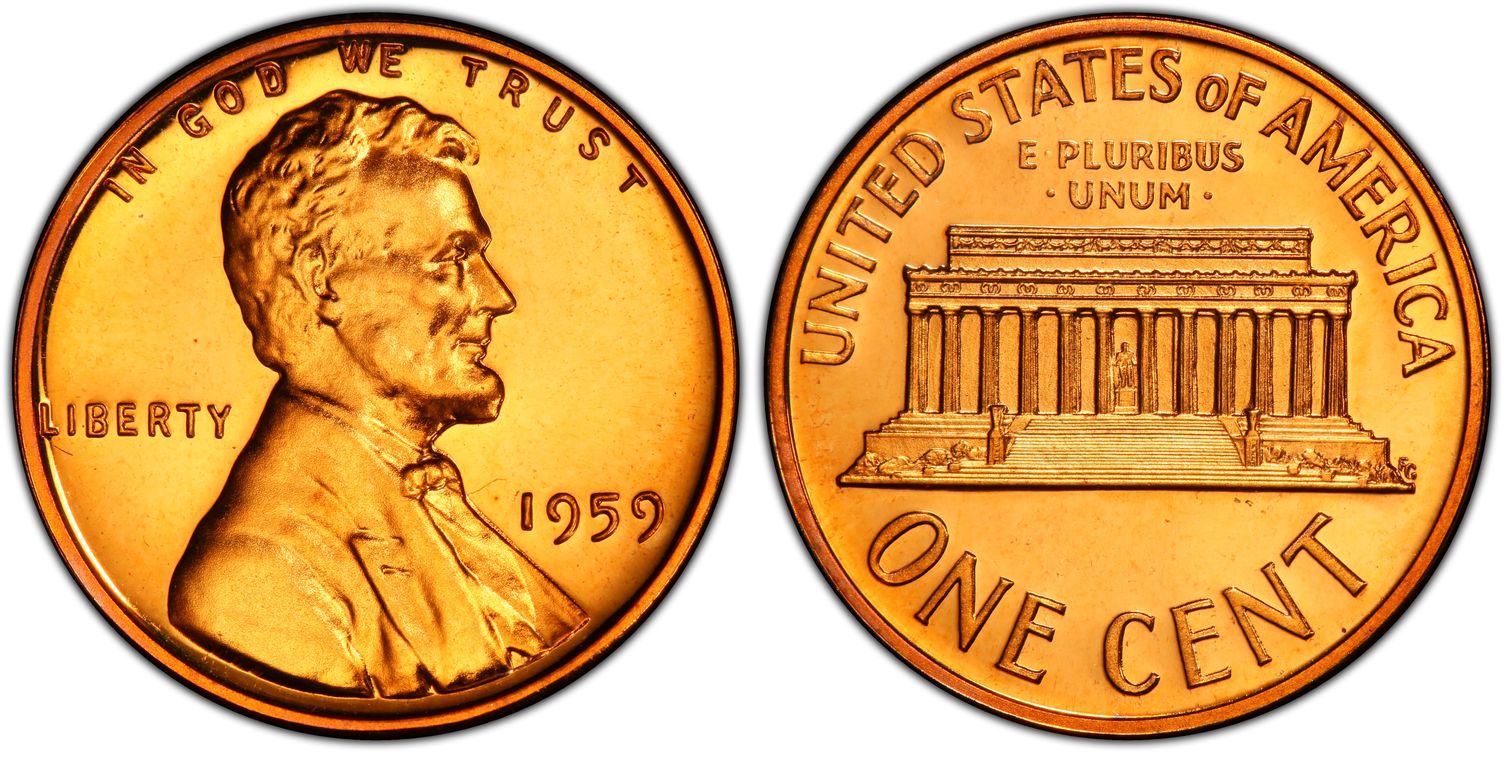
In PR67, these coins are rarely found as most have been removed from Proof Sets. In PR68, they are scarce, with high competition among collectors. In PR69, they are very scarce and represent the highest grade available, fetching as high as 20,000. PCGS has not graded any higher than PR69.
The 1959 Proof Coins in Deep Cameo condition are also considered rare. PCGS defines Deep Cameo (DCAM) as brilliant proofs that display deep, even frosting on the design elements of both sides of the coin. An estimated 175 to 225 proofs exhibit full Deep Cameo surfaces across all grades.
The auction record for a PR69 coin is $20,700 dollars, achieved in 2004 at Heritage Auctions.
See also our complete list of the most valuable pennies ever sold.
Final Words
In summary, the value of a 1959 Lincoln Penny is influenced by several factors, including its rarity, history, condition, design, mint marks, color, and any unique varieties or errors.
1959 Lincoln coins are relatively easy to find and purchase in average condition, and they are usually among the most common coins in the numismatic world.
Understanding these factors is crucial for determining the true worth of these coins. By considering all these elements, collectors and investors can make informed decisions about their 1959 pennies, like what price to anticipate for each coin. We hope to have encouraged you to start on a coin collecting journey or expand your existing collection.
















